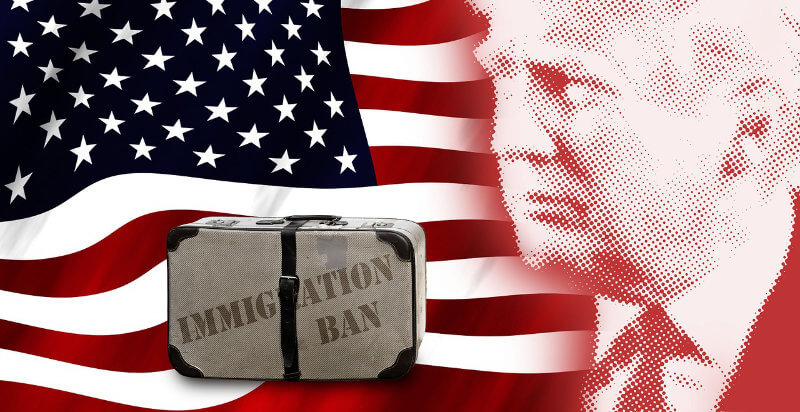Trump’s Immigration Policies: A Threat to Indian Family Life in the U.S
June 11, 2019 | Expert Insights

Background
Since 2017 Donald Trump has given US immigration laws a total make-over by pulling support from the Deferred Actions for Childhood Immigrants (DACA) program, restricting access to professional visas and work permits, limiting the opportunities of immigrant spouses, and tightening the strings on student visa regulations. Under Trump’s new administration, attempts have been made to redefine the qualifying criteria for the issue of H-1B visas which allow foreign workers to live and work in the U.S for up to six years. The purpose of the H-1B visa category was to try and reduce the growing skills-gap in America which seriously threatens the nation's economic growth. Indians account for about 76% of H-1B recipients and now the future of these workers hangs in the balance. Trump’s most recent immigration policy targets the spouses of H-1B visa holders who live in America under an H-4 visa. Previously, the H-4 visa allowed spouses to work and pursue a career in America, but a recent bill proposes to ban the issuance of work permits to H-4 visa holders. Trump believes that the Obama era visa policies are being misused by US companies to displace American jobs, but his new policies not only threaten the job security of thousands of Indians but also fail to address the problem of the American skill-gap which these immigrant workers help combat.
Analysis
Since 2017, The Department of Homeland Security in an attempt to redefine qualifications for the H-1B has worked to increase the standards for being considered a “skilled worker” and went on to reverse the lottery system for H-1B visas to favor workers who possess advanced degrees from a US university. This move essentially disqualifies a majority of Indian techies from obtaining a US visa and has led to a series of visa denials and rejections for extensions. In response to such policies, Indian IT firms have been forced to hire locally – this has resulted in lower profit margins due to higher labor costs which make Indian firms like WIPRO, Infosys, and Tata Consultancy services far less competitive. Indians working under an H-1B visa are 20% cheaper than workers who are sourced locally but continuous hikes in visa fees are undermining this advantage. Reports indicate that Trump wishes to use these fees to fund technical education for Americans, but we are yet to see such a measure being implemented.
The impact of Trump’s immigration crackdown isn’t felt by H-1B visa holders alone. Indians constitute 90% of H-4 visa recipients, a majority of whom are well educated female engineers who were gainfully employed and contributing to the US economy. The recent proposal to ban work permits issued to H-4 recipients is yet another deterring factor to Indians who wish to pursue a career in the USA. With these new immigration reforms, the United States is slowly threatening immigrant family life. Under Obama, the immigration system was sympathetic to family ties, but Trump’s ratified policies favour skills instead without paying heed to the repercussions of such decisions on family life. If spouses are denied the right to work, they are dissuaded from joining their partners in the US and several young children would be stripped of the luxury of living with both their parents. In fact, the children of Indian immigrant parents also stand to lose a lot since Trump pulled his support from DACA, an immigration policy which allows undocumented immigrant children to receive a renewable deferment of deportation and become eligible to receive a work permit in the US. In 2017, the Department of Homeland Security reported that there were 430,000 undocumented Indians in America and Trump’s new immigration laws threaten the security of each and every one of them.
Assessment
We predict that Trump’s immigration reform will result in wide-spread short-term unemployment in India as a result of hundreds of Indian workers returning to India after being denied visas or in response to the latest H-4 visa policy. This is concerning because India is currently experiencing rising unemployment issues with unemployment in April 2019 reaching 7.7%, the highest it has been since October 2016. To combat this, the Indian government should consider providing incentives for the expansion of domestic tech companies.
We also predict that there will be a decrease in the number of Indian students studying in the USA because of the limited return on investment for American degrees combined with bleak job prospects for Indian students post-graduation. Despite the obvious short-term hurdles, Trump’s immigration policies might actually benefit the Indian economy in the long term. Unemployed techies would be incentivized to take an entrepreneurial path and a reduction of brain drain would ensure that India’s greatest minds remain in India and contribute to its economic growth through research and innovation.
What remains unclear, is how Trump plans to combat the skill-gap that is bound to widen once skilled foreign workers leave the country. Without significant investments in education and training of the American workforce, US firms (especially in the service sector) will look for cheaper alternatives abroad and Trump’s plan might fail to boost the economy as planned.








Comments